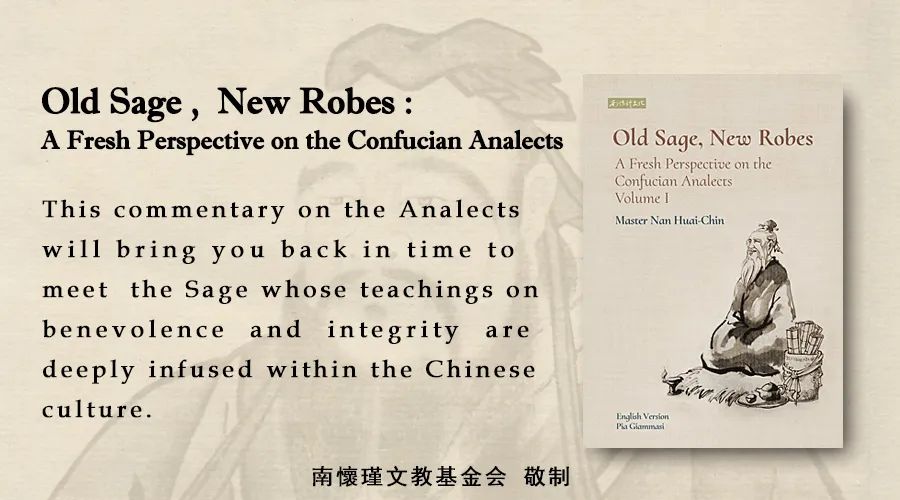本文系《论语别裁》英译本(南怀瑾文化事业有限公司2024年11月出版)的译者前言,作者为《论语别裁》英译本主译者Ms. Pia Giammasi(美国),中文名:纪雅云,1964年生于意大利,成长于美国,美国麻省大学法律系毕业,在厦门大学中医系获得中医专业本科及针灸专业本科文凭,在斯里兰卡凯拉尼亚大学巴利语与佛学研究院获硕士学位,游历多国,师从广泛,求道不辍,是南怀瑾先生著述《金刚经说什么》《人生的起点和终站》《心经修证圆通法门》《论语别裁》的英译本(皆已出版)译者,亦是至善社会福利基金会的发起人及董事长。
为方便中文读者,附本文的中文译文于后。中文译者张梦麟先生,英文名Abraham ,祖籍南粤梅州书香门第,生于西蜀彭州耕读之家,四川大学文学学士、历史学硕士、北京大学博士。

Introduction
This is a book by two masters, one ancient and one contemporary, both enigmatic. The lives of Confucius and Master Nan Huai-Chin (Nan Huaijin), in many ways, parallel each other. Both lived through tumultuous times, both had to leave their home state and wander only to return in old age to their birthplace. They were teachers, learned in many fields and arts and in life itself, but not scholars in the traditional sense. Both were criticized for being 乬jacks of all trades乭 without any specific profession, but in fact they were masters of all they engaged in.
They had students from all walks of life, were advisors of statesmen of all ranks and were flanked by loyal followers. They both seamlessly wove together the worldly and the spiritual. And both were most concerned about the decline of people乫s virtue, the deterioration of the culture, and of the general order of society.
I believe this is why Master Nan could go beyond the words of the ancient texts to see the man who spoke them, to understand the events of those ancient times, and to grasp the significance of his life乫s work. Master Nan stretched his reach across 2500
years to grasp the hand of Confucius who in turn was reaching further back into antiquity to hold the hand of King Wen and so forth. A chain of sages, each one stretching their arms as wide as possible, sleeves aflutter in the winds of change, holding tight to the treasures of the culture during chaotic times in order to pass them forward so they would be available to later generations and not disappear.
What is this precious treasure these sages guard on behalf of humanity? First and foremost, the spirit of benevolence (Ren 恗) within people乫s hearts and within the society at large.
Ren 恗, if I may venture to loosely define it, means intending the greatest good in everything one does throughout one乫s sphere of influence. This is the heart of civil society, be that one led by a king, or a council, this is the overriding principle. On top of that.like the cloak of the invisible man.is culture, which is the identifying force or the glue of the society. Culture gives people a sense of belonging and thus a clear place in the world. The innumerable arts which give form to culture embody our cultural identity, remind us of our cultural heritage, and will become our
legacy. Arts remind us of things beyond our everyday life, remind us of beauty, beauty within simplicity and within complexity. They may stimulate or calm us and bring us to peace and harmony within ourselves. They call us to explore and to question what is beyond human society, beyond nature, beyond this world and bring us closer to the spiritual.
Chinese culture is uniquely integral. It can be described as holographic or fractal in that there is repetition of core cultural elements at all ratios from micro to macro.so that even a traditional Chinese hand-held wooden
scale with hanging counterweights found at any street market stall or chinese medicine shop contains elements of cosmology, numerology, philosophy, etc. and reminds the user to reflect on whether or not they are acting with benevolence and integrity so as to promote harmony in the world. And it is synergistic in that what comes before yin and yang is indivisible and defies description, and what comes after is simply everything. There are few cultures in the world which are so cohesive and which are based on the central spirit of benevolence. Thus sages such as Confucius and Master
Nan dedicated their lives to ensuring that this great spirit lives on in people乫s minds and hearts.
In general, commentaries on Confucian classics are like reference books, simply defining terminology and not straying too far from the status quo. Master Nan乫s commentary was not only a fresh perspective but was also a whole new genre, full of stories, background information, humor, insights, history and so forth. The two volume set was compiled from class lectures held in the 1960-70乫s in Taiwan and took the Chinese speaking world by storm, selling millions of copies.
One thing must be taken into consideration, some of the information or references spoken of were from Master Nan乫s memory or from sources which could not be checked or, in some cases, may have even been unreliable. In this regard, certain insignificant details in Master Nan乫s works do not stand up to acerbic academic scrutiny, but the students who prepared the lecture recordings for publication did the best they could to check quotes or facts in the pre-computer age.
As these great sages are no longer with us, it falls upon us to carry forth
the torch. What would it take to create the educated egalitarian society, the meritocracy envisioned by Confucius丠Perhaps you, who are reading this book, will find a way to take us a step closer.
Editor-in-Chief
Pia Giammasi
《论语别裁》英译本译者前言
英文原作者:纪雅云
中文译者:张梦麟
本书内容乃出自两位传奇大师,一位是古代的孔子,一位是现代的南怀瑾先生。两位大师的生命历程颇多相似之处:都经历了天下“礼崩乐坏”的动荡时期,都在此期间被迫离开故土而漂泊他乡,又都在晚年最终回归家邦;皆为人师,博通百家之学、深明宇宙人生之道,却绝非普通习俗意义上的学者;两位大师皆因“博学而无所成名”而遭物议,实则他们均为所涉足领域之宗师级人物;其门生皆遍及世间各行业和阶层,其皆为各级领导管理层之导师或顾问,其身边皆常簇拥着忠实的弟子们;两位大师皆秉为天地立心之愿而行于其所处之乱世①,皆源于对人文精神之凌夷、天下礼崩乐坏之忧患也。
职是之故,南师能超越时空与文字而直见孔子之微言大义,透过其所述齐桓晋文之史事,真切体会孔子毕生事业之意义。他跨越两千五百年时光,与孔子把臂同行,恰如孔子昔日回望更古老的岁月而与文王携手共进,而文武周公也曾超越时空拥抱尧舜禹汤……先圣先贤们一脉相承,弘展双臂,衣袖翩然于人世沧桑,只为守护人文瑰宝即先王之正道不绝,以利天下万世生民之命②。
先圣先贤所守护之人文瑰宝其内涵究竟为何?其首要者,乃是内在于人心和社会的仁之精神。这一精神——如大胆给一个宽泛的界定的话,当一个人具备仁的精神,则意味着其做任何事情都会在其力所能及范围内以追求至善为目的。仁的精神是文明社会之心,无论其政体为君主制还是共和制,这一精神都是其首要原则。这一精神的最重要表现则为文化——类似隐形人的外衣③,文化的力量促进着社会认同和融合。人们因文化而获得归属感,并进而各安其位。而无数承载着文化的艺术作品,则体现着我们的文化身份,唤醒着我们的文化记忆,其本身也将成为我们的文化遗产。艺术提醒我们超越日常生活的桎梏,唤醒我们对美的感知——无论是简约之美还是繁复之美。它们或激荡人心,或抚慰心灵,并可将我们带入自己内在的中和状态。艺术召唤我们去探索和质疑超越人类社会、超越自然界和超越当下世界的领域,并由此引导我们步入更深的精神境界。
中华文化独特之整体性可被描述为全息或分形:从宏观到微观,其核心元素都能以各种比例各种形态复现——以至于在任何一个街边小摊或中药铺里随处可见的悬挂着秤砣的中国传统木秤,都蕴含其核心之宇宙观念、命理观念和哲学观念等元素。这一木秤还时时提醒使用者反思自己的心行是否仁义正直,而中华文化认为,一个人的起心动念事关天下和谐。中华文化还具有协同性特点,阴阳未分之前的浑然一体、不可名状,在阴阳剖分之后则化生出日常万物。世所罕见的特点是,中华文化既具有很强的内在凝聚力,同时又是以“天下为公”、绝不排他的真正普世的“仁”的精神为其核心元素④。因此,像孔子和南师这样的圣贤,会毕生致力于确保这一伟大的文化精神能在人们的思想和心灵中传承下去。
儒家经典注疏,通常更像是参考书目汇编,仅有的解释也偏学究气,鲜有突破既定框架。而南师的讲述不但视角新颖,更开创了一种全新的、融故事、背景、幽默、洞见和历史等于一体的经典解释体裁。我们这套四卷本英文版是基于原来的两卷本中文版——整理自1960-70年代南师在台湾的课堂讲录,甫一出版便风靡华语世界,销量逾百万册。但有一点需稍微注意的是,书中一些内容是基于南师的记忆或未经核实的文献,故偶有细节未必经得起严苛的学术推敲。然而,整理讲录的师友们已竭尽所能考证了引文与史实,这在电脑尚未普及的年代已属难能可贵。
如今这些伟大的圣贤已离我们而去,传承这一人文智慧圣火的重任即落在了我们肩上。如何实现孔子理想中“选贤与能”的大同世界?也许,正在阅读这本书的你,会找到一条让我们更接近这一目标的道路。
本书主译 纪雅云
附注:
①英文行文简练含蓄,直译是“两位大师都将世俗与精神完美融合”,而更能让中文读者明白的句子可能应该译为“两位大师皆以出世之心行入世之事业”。与纪雅云老师讨论之后,又为照顾到此句与后面一句之关系,故最后定为目前译文。
②本段翻译使用了原文中没有的“齐桓晋文之史事”、“文武周公”、“尧舜禹汤”、“先圣先贤”、“先王之正道”、“天下万世生民之命”等比较地道的中文表达,主要是从体会其内在意义考虑的。后来与纪雅云老师讨论,对此做了解释。更为生动的是,雅云老师特别提到,她写这段英文时,心中自然呈现了南师、孔子、文王等先圣贤超越时空携手于大风中的人世间的画面,中文译者恰恰也为其英文描述的场景所大为感动!故最后雅云老师对此段译文非常认可。
③这里的“隐形人”出典于欧美同名电影,作者借此说明,“仁”的精神类似于“隐形人”,只能借助于“文化”这件外衣,才能为人所感知。
④ 为了尽量精准译好这句话,译者独自琢磨并请教包括雅云老师等师友的次数和时间最多最长。这似乎真切反映了译者作为受过现代西方知识形态教育且身处中华文化之中的现代人,对理解自己的文化特征并不那么自然而顺畅的事实。雅云老师分享说,她之所以体会到中华文化的这个“世所罕见”的特征,一方面是由于她有幸接受了南师的教化,故略微能入乎中华文化之内,一方面是她对其母体的欧美文化比较熟悉,故能出乎中华文化之外来观照。译者闻之不禁赞叹曰:此真文明互鉴也!

